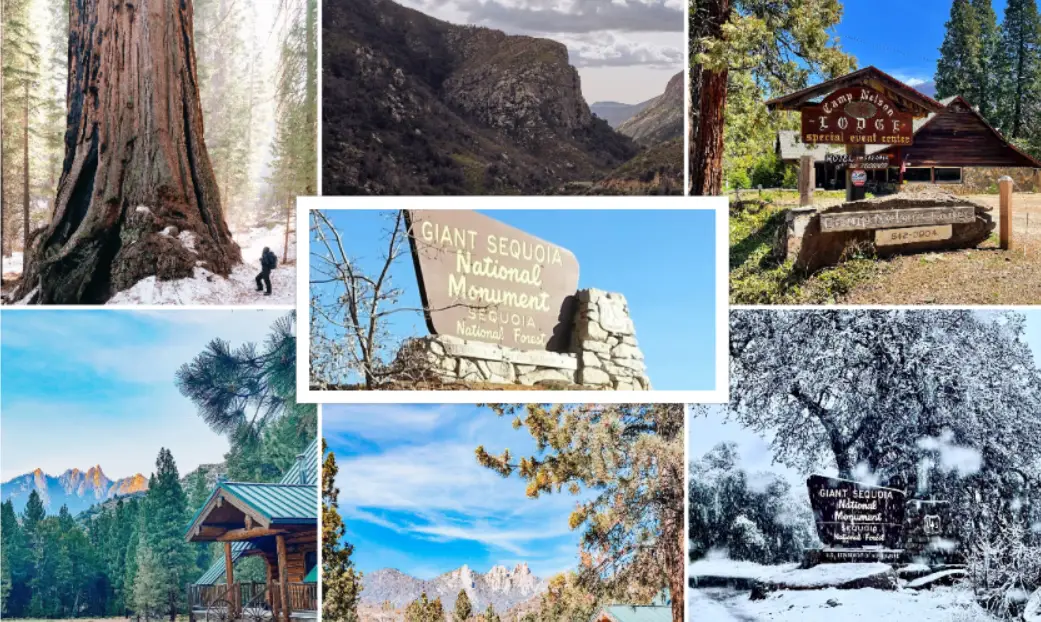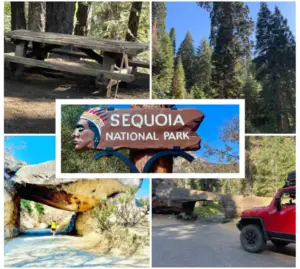Giant Sequoia National Monument : Interesting Facts, History & Travel Guide

- By
- Aparna Patel
- |
- 1 Apr, 2023
- |

Welcome to our guide to the Giant Sequoia National Monument, a protected area in the southern Sierra Nevada mountain range of California. This monument is home to some of the largest trees in the world and offers visitors a range of recreational activities, from hiking and camping to wildlife viewing and ranger-led programs.
In this blog post, we’ll delve into the history and significance of the giant sequoia trees, provide some interesting facts about the monument, and offer a travel guide to help you plan your visit. So let’s explore the wonder and beauty of the Giant Sequoia National Monument together!
Table of Contents
Interesting facts about Giant Sequoia National Monument
- The Giant Sequoia National Monument is located in the southern Sierra Nevada mountain range in California, USA.
- The monument was established in April 2000 by President Bill Clinton and covers over 328,000 acres.
- The monument is home to over 33 groves of giant sequoia trees, which are the largest trees in the world by volume.
- The oldest sequoia trees in the monument are estimated to be over 3,000 years old.
- The largest tree in the monument is the General Sherman Tree, which stands over 275 feet tall and has a diameter of over 36 feet at its base.
- The giant sequoia trees are fire-adapted, meaning that they have evolved to withstand and benefit from natural wildfires.
- The monument is also home to a diverse range of wildlife, including black bears, mountain lions, and the endangered California condor.
- The monument offers a range of recreational activities, including hiking, camping, and fishing.
- The monument is open year-round, although some areas may be inaccessible during the winter months due to snow.
- The Giant Sequoia National Monument is a popular destination for nature enthusiasts, scientists, and photographers, and attracts over 1.5 million visitors each year.
Information & History of Giant Sequoia National Monument
The monument was established to protect these ancient trees and their surrounding ecosystems from logging, mining, and other destructive activities. The monument is home to a diverse range of wildlife, including black bears, mountain lions, and the endangered California condor.
The area has a rich history, with evidence of human habitation dating back over 7,000 years. The indigenous people of the area, including the Yokut and Western Mono tribes, used the giant sequoia trees for a variety of purposes, including food, shelter, and ceremonial purposes.
During the 19th century, the giant sequoia trees became a popular attraction for tourists, and many of the trees were cut down for commercial purposes. In response to the destruction, conservationists and activists fought to protect the remaining trees, leading to the establishment of the Giant Sequoia National Monument.
Today, the monument offers a range of recreational activities, including hiking, camping, and fishing. It is a popular destination for nature enthusiasts, scientists, and photographers, and attracts over 1.5 million visitors each year. The monument also serves as an important research site, with scientists studying the ecology and biology of the giant sequoia trees and their surrounding ecosystems.
Read More:
- George Washington Carver National Monument : Interesting Facts, History & Travel Guide
- Freedom Riders National Monument : Interesting Facts, History & Travel Guide
- Fossil Butte National Monument : Interesting Facts, History & Travel Guide
- Fort Union National Monument : Interesting Facts, History & Travel Guide
- Fort Stanwix National Monument : Interesting Facts, History & Travel Guide
Travel Guide for Giant Sequoia National Monument
- When to go: The monument is open year-round, but the best time to visit is during the summer months from June to September when the weather is warm and dry.
- How to get there: The nearest airports are in Fresno and Bakersfield. You can also drive to the monument from Los Angeles or San Francisco, both of which are about a 4-hour drive away.
- Where to stay: There are several campgrounds within the monument that offer tent and RV camping. There are also cabins and lodges available outside of the monument in nearby towns like Three Rivers and Springville.
- What to do: The monument offers a range of recreational activities, including hiking, camping, fishing, and scenic drives. Some popular attractions include the General Sherman Tree, Moro Rock, and the Giant Forest Museum.
- Hiking trails: There are over 84 miles of hiking trails in the monument, ranging from easy nature walks to challenging backcountry hikes. Some popular trails include the Congress Trail, the Crescent Meadow Trail, and the High Sierra Trail.
- Ranger-led programs: The monument offers a variety of ranger-led programs, including guided hikes, campfire talks, and educational programs for children.
- Wildlife viewing: The monument is home to a variety of wildlife, including black bears, mountain lions, and the endangered California condor. Visitors should exercise caution and follow safety guidelines when encountering wildlife.
- Leave no trace: It’s important to practice leave no trace principles while visiting the monument. This includes packing out all trash, staying on designated trails, and respecting wildlife and vegetation.
- Other nearby attractions: There are several other nearby attractions worth visiting, including Kings Canyon National Park, Sequoia National Forest, and Yosemite National Park.
- Permits and fees: There is no entrance fee for the Giant Sequoia National Monument, but some campgrounds and activities may require permits or fees. Make sure to check the monument’s website for current information on permits and fees.
Read More Articles:
- Fort Matanzas National Monument : Interesting Facts, History & Travel Guide
- Florissant Fossil Beds National Monument : Interesting Facts, History & Travel Guide
- Fort Frederica National Monument : Interesting Facts, History & Travel Guide
- Yosemite National Park: Interesting Facts, History & Information
- Fort Pulaski National Monument : Interesting Facts, History & Travel Guide
- Fort Ord National Monument : Interesting Facts, History & Travel Guide
FAQ about Giant Sequoia National Monument
What is the significance of the giant sequoia trees?
The giant sequoia trees are the largest trees in the world by volume and have been living in the area for thousands of years. The oldest sequoia trees in the monument are estimated to be over 3,000 years old.
What is the General Sherman Tree?
The General Sherman Tree is the largest tree in the monument, standing over 275 feet tall and having a diameter of over 36 feet at its base. It is estimated to be around 2,200 years old and is a popular attraction for visitors.
What activities can visitors do at the Giant Sequoia National Monument?
Visitors can enjoy a range of recreational activities at the monument, including hiking, camping, fishing, and scenic drives. The monument also offers ranger-led programs, educational programs for children, and wildlife viewing opportunities.
What wildlife can visitors see at the monument?
The monument is home to a diverse range of wildlife, including black bears, mountain lions, and the endangered California condor. Visitors should exercise caution and follow safety guidelines when encountering wildlife.
What is the best time to visit the monument?
The best time to visit the monument is during the summer months from June to September when the weather is warm and dry. However, the monument is open year-round.
What nearby attractions are worth visiting?
There are several nearby attractions worth visiting, including Kings Canyon National Park, Sequoia National Forest, and Yosemite National Park.
Are there any fees or permits required to visit the monument?
There is no entrance fee for the Giant Sequoia National Monument, but some campgrounds and activities may require permits or fees. Visitors should check the monument’s website for current information on permits and fees.
How can visitors get to the monument?
Visitors can fly into the nearest airports in Fresno and Bakersfield or drive from Los Angeles or San Francisco.
Search Posts
Latest posts
-
4 Mar, 2024
How to make dining alone less awkward?
-
4 Mar, 2024
Can I accidentally miss the in-flight food?
Popular posts
-
5 Mar, 2024
Why prohibit engine braking?
